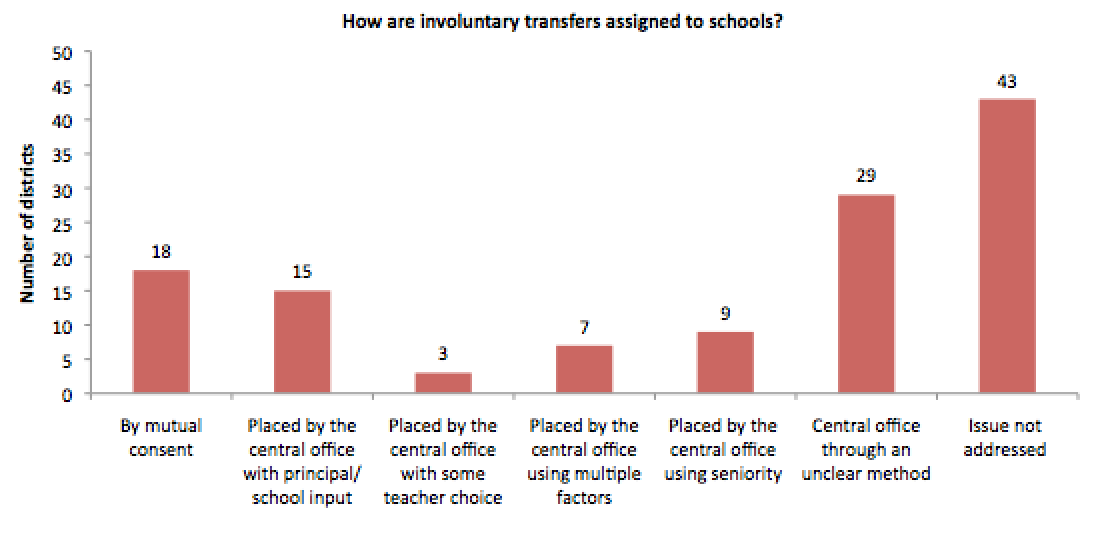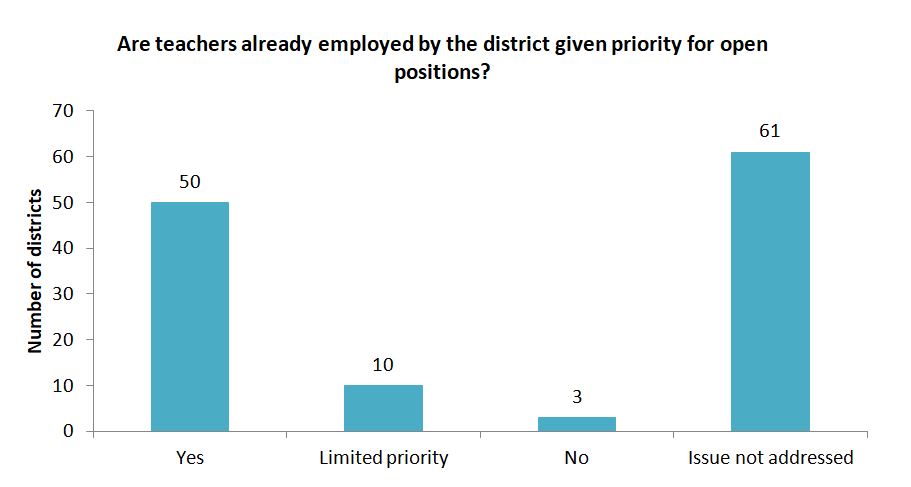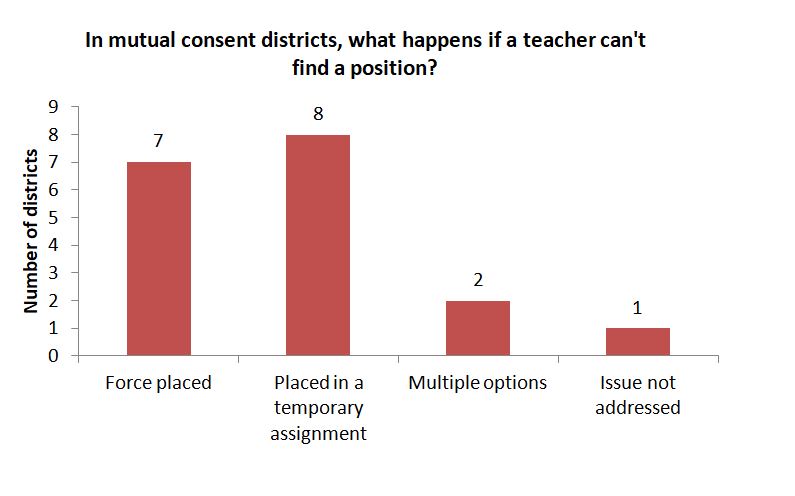District Trendline, previously known as Teacher Trendline, provides actionable research to improve district personnel policies that will strengthen the teacher workforce. Want evidence-based guidance on policies and practices that will enhance your ability to recruit, develop, and retain great teachers delivered right to your inbox each month? Subscribe here.
Every year, shifts in school enrollment, programs, or other factors require schools to transfer some teachers out of their current position at a school. But how do those teachers find a new position — and what happens to the teachers who can’t? Up until recently, the New York City Department of Education gave its principals the right to accept or reject any teacher who applied for a position in their school and also gave its teachers the right to accept or reject any position offered to them. That process is called mutual consent. Districts that choose to adopt mutual consent generally have to keep teachers on their payroll, as most states prohibit districts from dismissing teachers on the basis of no school wanting to hire such teachers. So instead of being laid off, New York’s teachers were placed in its “Absent Teacher Reserve,” (ATR) where they were allowed to collect their regular salaries in spite of not having a permanent classroom position—though many worked as substitutes. On July 10th, New York announced that it will now force place some teachers from the ATR into full-time teaching positions, in a departure from its previous policy of allowing teachers to stay in the ATR until they found a position through mutual consent.
Spoiler alert: while the cost of the Annual Teacher Reserve was $100 million, approximately 0.4 percent of New York schools’ budget, New York’s move to force place teachers in the ATR is a major step backwards for teacher quality.
Is the concept of mutual consent just too expensive? Let’s take a look at what happens in other districts across the country when teachers have to transfer schools.
Assigning transfers to schools
In our 124 districts, the central office is largely responsible for finding new positions for teachers whose positions have been eliminated. In nine of these districts, the central office places teachers using their preferences by seniority. In three other districts, the central office uses a variety of factors, including teacher effectiveness, staffing for co-curricular activities, and other district needs. For example, Winston-Salem/Forsyth County School (NC) places teachers in a way that attempts to maintain equal levels of experience across schools.
Some districts allow more substantial teacher or principal input into a teacher’s final placement, although central office ultimately makes the decision. In fifteen districts, principals have a significant say in what teachers are transferred into their school. For example, the Indianapolis Public Schools central office provides its principals with a list of teachers from which they can hire, although in the end every teacher is placed in a position. In three districts, teachers have more input into their placement than merely expressing preferences to human resources. In Fresno Unified School District (CA), teachers interview at their preferred schools and then choose their position, with the central office making the final decision if more than one teacher requests the same job.

Most districts still give priority to teachers who are being involuntarily transferred over new hires. Only three of the 124 districts,Burlington Public Schools (VT), Prince William County Public Schools (VA), and St. Paul Public Schools (MN),give no preference to teachers currently employed in the school system. In six districts, including Henrico County Public Schools (VA) and Davis School District (UT), principals are required to interview two or three teachers who are already employed by the district before considering any new applicants, but they are under no obligation to hire one of these internal candidates.

Mutual Consent
Of greater interest are the 18 districts, or almost 15 percent, that have adopted some form of mutual consent, ensuring that both principals and teachers have an opportunity to accept or reject an applicant or a position, respectively. Some of these districts, such as Cherry Creek School District (CO) and Boston Public Schools, use a process that fits the classical definition of mutual consent, in which principals and teachers must agree on a placement match. Other districts use a slightly modified mutual consent process. For example, Chicago Public Schools allows principals to select any pre-qualified applicant, which includes new teachers who passed a uniform pre-screening process or displaced teachers whose evaluation rating was one of the top two categories, but teachers do not apply directly to these positions.

Because the mutual selection process is largely predicated on choice, some teachers may not find a match, thus explaining why mutual consent is so controversial. Colorado state law requires the use of mutual consent and allows districts to ultimately place teachers who cannot find a position on unpaid leave. Both Jeffco Public Schools (CO) and Douglas County School District (CO) initially assign displaced, tenured teachers to temporary positions. If after one year, or two hiring cycles, those teachers have still not found a mutual consent position, Jeffco puts them in a priority hiring pool and on unpaid leave, whereas Douglas County force places them in permanent positions.
In two of the 18 mutual consent districts, teachers have options if they do not find a position. Options for teachers in Oakland Unified School District include forced placement by preference and seniority, a position in the central office, or remaining in the talent pool. In District of Columbia Public Schools, teachers can receive a buyout, or a temporary assignment with full salary, or, if eligible, they can retire early with full benefits.
Is the cost of mutual consent too high?
Both New York City and Boston have been in the news recently for the high cost of their mutual consent policies. Given the large cost associated with mutual consent, it is easy to see why districts may resort to a suboptimal policy of force placing teachers who do not find a mutual consent position. Districts find themselves trying to navigate this tension between keeping costs low and ensuring that principals do not have to hire a teacher who is not a good fit.
Only districts in the state of Colorado and Chicago Public Schools have managed to solve this issue. The Colorado state law, mentioned above, that allows districts to put teachers on unpaid leave if they cannot find a permanent position after two hiring cycles reduces the cost often associated with mutual consent. In Chicago, under a state law that only applies to Chicago and no other district in the state, if 50 percent of the district’s vacancies are not filled by displaced tenured teachers, the district will assign some number of these displaced teachers back into the pool of candidates from which principals may hire for another five months. If a teacher still has not found a position after that time, they serve as a substitute for five months while continuing to look for a permanent position. If, at that time, a teacher has not secured a permanent position they will be laid off.
The Teacher Contract Database includes information on 147 school districts and 2 charter management organizations in the United States including: the 100 largest districts in the country, the largest district in each state, and the member districts of the Council of Great City Schools. The database features answers to over 100 policy questions and provides access to teacher contracts, salary schedules, and board policies in addition to relevant state laws governing teachers.

